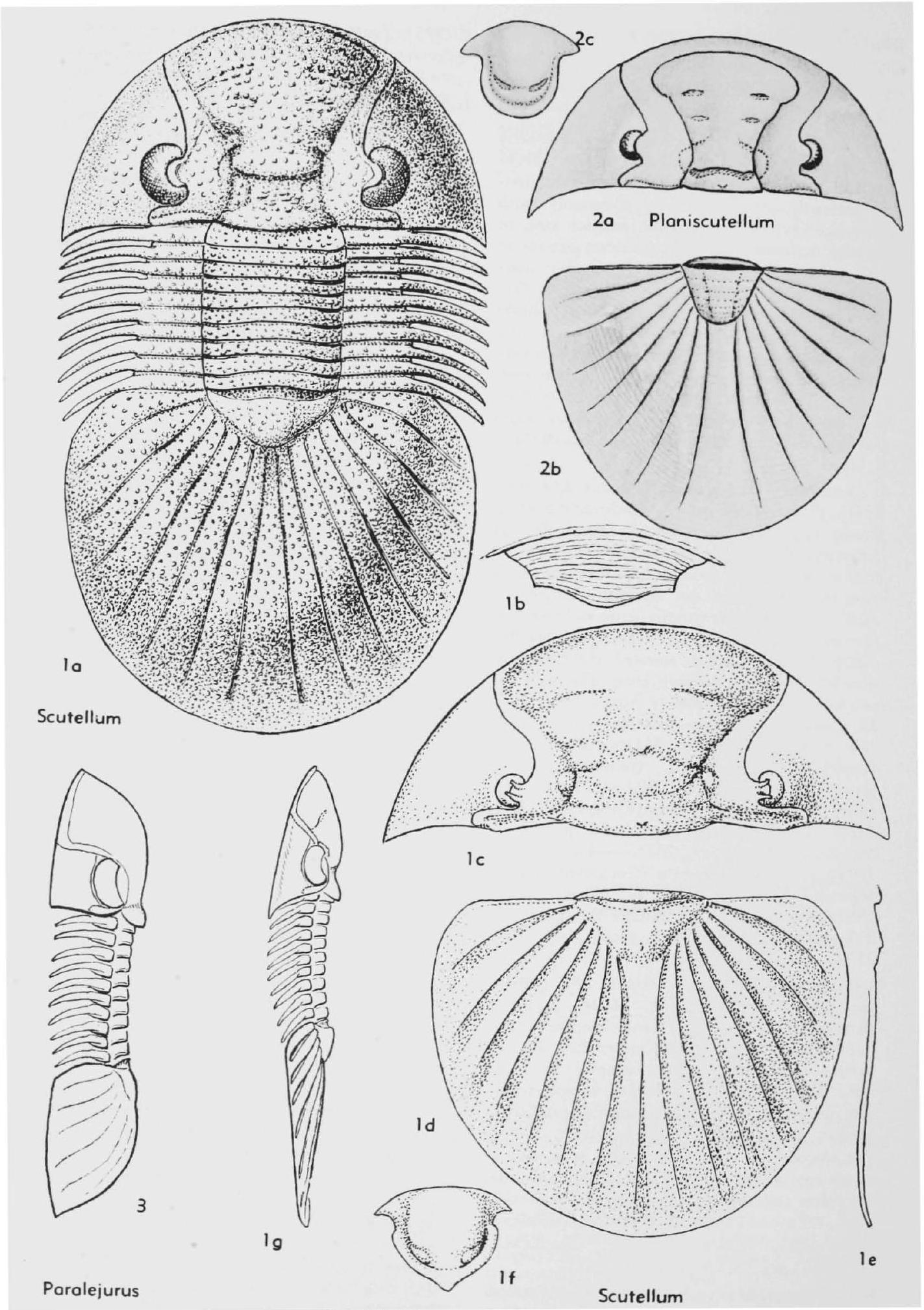Welcome to the Treatise on Invertebrate Paleontology!
Please enter a genera name to retrieve more information.

Scutellum
Classification
Phylum:
Arthropoda
Subphylum:
Trilobitomorpha
Class:
Trilobita
Order:
Ptychopariida
Suborder:
Illaenina
Superfamily:
Illaenacea
Family:
Thysanopeltidae
Formal Genus Name and Reference:
Scutellum Pusch, 1833
Type Species:
S. costatum
Images
(Click to enlarge in a new window)
Fig. 279, la, b. *S. (S.) costatum, M.Dev.(Givet. ), Ger. (Iserlohn), 1a, b, exoskel. (reconstr. ), rostral plate, x1 (257)., Fig. 279, 1c-f. S. (S.) paliferum (Beyrich), L.Dev. (Koněprusy Ls. ), Czech., 1c, ceph., 1d, e, pyg., dorsal, profile, 1f, hypostoma, all x1 (3, 257)., Figs. 278, 3a, 279, 1g. S. (S.) flabelliferum (Goldfuss), M.Dev. (Couvin. ), Ger. (Eifel), 278, 3a, ridged thoracic pleura with anterior and posterior flanges, x1.5, Fig. 279, 1,g, exoskel. (reconstr. ), profile, x1 (243, 257).
Synonyms
Brontes, Bronteus
Geographic Distribution
cosmop.
Age Range
Beginning Stage in Treatise Usage:
Sil.
Beginning International Stage:
Rhuddanian
Fraction Up In Beginning Stage:
0
Beginning Date:
443.07
Ending Stage in Treatise Usage:
U.Dev.
Ending International Stage:
Famennian
Fraction Up In Ending Stage:
100
Ending Date:
359.3
Description
Glabella gradually expanding forward, occipital furrow commonly with tumor-like swelling at each end, anterior areas of fixigenae narrowing forward, posterior sections of facial sutures parallel and close to posterior margin, reaching it by abrupt inward bending (except Planiscutellum), anterior sections of sutures approaching axial furrows forward, oblique eye ridges commonly present. Thoracic axis narrower than pleurae (except Paralejurus). Pygidium with 7 lateral ribs, median rib simple or bifurcate. Surface may bear tubercles on glabella, occipital ring, palpebral lobes, and axis of thorax and pygidium. Cephalon flat or only moderately convex, frontal area narrow or absent, lateral furrows differentiated (1p curving forward to join 2p furrows in manner reducing 2p lobes to small tubercles, 3p furrows not distinctly limited adaxially, supplementary groove between 2p and 3p furrows commonly present). Pygidium rather flat, commonly with central elevated platform surrounded by flat or concave zone, ribs well developed, doublure extremely broad. Shell thin.
References
Museum or Author Information
Classification
Phylum:
Arthropoda
Subphylum:
Trilobitomorpha
Class:
Trilobita
Order:
Ptychopariida
Suborder:
Illaenina
Superfamily:
Illaenacea
Family:
Thysanopeltidae
Formal Genus Name and Reference:
Scutellum Pusch, 1833
Type Species:
S. costatum
Images
(Click to enlarge in a new window)
Fig. 279, la, b. *S. (S.) costatum, M.Dev.(Givet. ), Ger. (Iserlohn), 1a, b, exoskel. (reconstr. ), rostral plate, x1 (257)., Fig. 279, 1c-f. S. (S.) paliferum (Beyrich), L.Dev. (Koněprusy Ls. ), Czech., 1c, ceph., 1d, e, pyg., dorsal, profile, 1f, hypostoma, all x1 (3, 257)., Figs. 278, 3a, 279, 1g. S. (S.) flabelliferum (Goldfuss), M.Dev. (Couvin. ), Ger. (Eifel), 278, 3a, ridged thoracic pleura with anterior and posterior flanges, x1.5, Fig. 279, 1,g, exoskel. (reconstr. ), profile, x1 (243, 257).
Synonyms
Brontes, Bronteus
Geographic Distribution
cosmop.
Age Range
Beginning Stage in Treatise Usage:
Sil.
Beginning International Stage:
Rhuddanian
Fraction Up In Beginning Stage:
0
Beginning Date:
443.07
Ending Stage in Treatise Usage:
U.Dev.
Ending International Stage:
Famennian
Fraction Up In Ending Stage:
100
Ending Date:
359.3
Description
Glabella gradually expanding forward, occipital furrow commonly with tumor-like swelling at each end, anterior areas of fixigenae narrowing forward, posterior sections of facial sutures parallel and close to posterior margin, reaching it by abrupt inward bending (except Planiscutellum), anterior sections of sutures approaching axial furrows forward, oblique eye ridges commonly present. Thoracic axis narrower than pleurae (except Paralejurus). Pygidium with 7 lateral ribs, median rib simple or bifurcate. Surface may bear tubercles on glabella, occipital ring, palpebral lobes, and axis of thorax and pygidium. Cephalon flat or only moderately convex, frontal area narrow or absent, lateral furrows differentiated (1p curving forward to join 2p furrows in manner reducing 2p lobes to small tubercles, 3p furrows not distinctly limited adaxially, supplementary groove between 2p and 3p furrows commonly present). Pygidium rather flat, commonly with central elevated platform surrounded by flat or concave zone, ribs well developed, doublure extremely broad. Shell thin.
